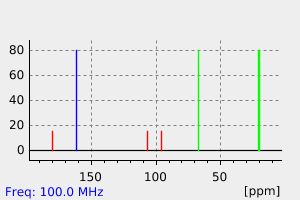5-(trichloroacetyl)-3,4-dihydro-2H-pyran | 83124-87-2
中文名称
——
中文别名
——
英文名称
5-(trichloroacetyl)-3,4-dihydro-2H-pyran
英文别名
3,4-Dihydro-5-trichloroacetyl-2H-pyran;3-trichloroacetyl-5,6-dihydro-4H-pyran;5-trichloroacetyl-3,4-dihydro-2H-pyran;2,2,2-trichloro-1-(3,4-dihydro-2H-pyran-5-yl)ethanone
CAS
83124-87-2
化学式
C7H7Cl3O2
mdl
MFCD24842869
分子量
229.49
InChiKey
PWNGCQDVIQOYBS-UHFFFAOYSA-N
BEILSTEIN
——
EINECS
——
-
物化性质
-
计算性质
-
ADMET
-
安全信息
-
SDS
-
制备方法与用途
-
上下游信息
-
文献信息
-
表征谱图
-
同类化合物
-
相关功能分类
-
相关结构分类
物化性质
-
沸点:132 °C(Press: 10 Torr)
-
密度:1.487±0.06 g/cm3(Predicted)
计算性质
-
辛醇/水分配系数(LogP):2.4
-
重原子数:12
-
可旋转键数:1
-
环数:1.0
-
sp3杂化的碳原子比例:0.571
-
拓扑面积:26.3
-
氢给体数:0
-
氢受体数:2
反应信息
-
作为反应物:描述:5-(trichloroacetyl)-3,4-dihydro-2H-pyran 在 sodium hydroxide 、 lithium aluminium tetrahydride 作用下, 生成 Tetrahydro-2-methoxy-3-pyranmethanol参考文献:名称:环磷酰胺双环“预活化”类似物的合成和构型分配摘要:新型的环磷酰胺,3- [双(2-氯乙基)氨基] -2-氮杂-3-磷酸-4,10-二氧杂双环(4.4.0)癸烷3-氧化物的双环“预活化”类似物的合成是描述。立体异构体的构型分配通过31 P和1 H NMR进行。DOI:10.1016/s0040-4039(00)94655-0
-
作为产物:描述:2-Chlor-3-trichloracetyl-tetrahydro-4H-pyran 60.0 ℃ 、2.0 kPa 条件下, 以84%的产率得到5-(trichloroacetyl)-3,4-dihydro-2H-pyran参考文献:名称:A biomimetic approach to plumericin摘要:DOI:10.1021/ja00360a056
文献信息
-
Synthesis of hydroxypyrazoles and 1-methyl-3-isoxazolones via haloform reactions作者:Alex F.C. Flores、Nilo Zanatta、Adriano Rosa、Sergio Brondani、Marcos A.P. MartinsDOI:10.1016/s0040-4039(02)00874-2日期:2002.7hydroxypyrazoles (2a–f) and 2-methyl-3-isoxazolones (3a–d) from the cyclocondensation reaction of trichloromethyl-substituted 1,3-dielectrophiles (1a–f) with dry hydrazine and N-methylhydroxylamine is reported. The regiospecific cyclocondensation took place with the elimination of the trichloromethyl group in a haloform type reaction when acetonitrile under basic medium was used. The structure of compounds 2
-
A simple one-pot synthesis of 3-alkoxy-3-cyanocarboxylic acids: a rapid entry to new GABA derivatives作者:Nilo Zanatta、Fabio M. da Silva、Luciana S. da Rosa、Louíse Jank、Helio G. Bonacorso、Marcos A.P. MartinsDOI:10.1016/j.tetlet.2007.07.060日期:2007.9A simple one-pot procedure to obtain a series of new 3-alkoxy-3-cyanocarboxylic acids from the reaction of 4-alkoxy-1,1,1-trichloro-but-3-en-2-ones with sodium cyanide is described.
-
Synthesis and Neuroprotective Action of Xyloketal Derivatives in Parkinson’s Disease Models作者:Shichang Li、Cunzhou Shen、Wenyuan Guo、Xuefei Zhang、Shixin Liu、Fengyin Liang、Zhongliang Xu、Zhong Pei、Huacan Song、Liqin Qiu、Yongcheng Lin、Jiyan PangDOI:10.3390/md11125159日期:——Parkinson’s disease (PD) is the second most common neurodegenerative disease affecting people over age 55. Oxidative stress actively participates in the dopaminergic (DA) neuron degeneration of PD. Xyloketals are a series of natural compounds from marine mangrove fungus strain No. 2508 that have been reported to protect against neurotoxicity through their antioxidant properties. However, their protection versus 1-methyl-4-phenylpyridinium (MPP+)-induced neurotoxicity is only modest, and appropriate structural modifications are necessary to discover better candidates for treating PD. In this work, we designed and synthesized 39 novel xyloketal derivatives (1–39) in addition to the previously reported compound, xyloketal B. The neuroprotective activities of all 40 compounds were evaluated in vivo via respiratory burst assays and longevity-extending assays. During the zebrafish respiratory burst assay, compounds 1, 9, 23, 24, 36 and 39 strongly attenuated reactive oxygen species (ROS) generation at 50 μM. In the Caenorhabditis elegans longevity-extending assay, compounds 1, 8, 15, 16 and 36 significantly extended the survival rates (p < 0.005 vs. dimethyl sulfoxide (DMSO)). A total of 15 compounds were tested for the treatment of Parkinson’s disease using the MPP+-induced C. elegans model, and compounds 1 and 8 exhibited the highest activities (p < 0.005 vs. MPP+). In the MPP+-induced C57BL/6 mouse PD model, 40 mg/kg of 1 and 8 protected against MPP+-induced dopaminergic neurodegeneration and increased the number of DA neurons from 53% for the MPP+ group to 78% and 74%, respectively (p < 0.001 vs. MPP+ group). Thus, these derivatives are novel candidates for the treatment of PD.帕金森病(PD)是影响55岁以上人群的第二常见的神经退行性疾病。氧化应激积极参与PD的多巴胺(DA)神经元退化。木酮糖是一系列从海桑菌株No.2508中分离出来的天然化合物,据报道它们通过其抗氧化特性来抵御神经毒性。然而,它们对1-甲基-4-苯基吡啶(MPP+)-诱导的神经毒性的保护作用仅中度,因此需要适当的结构修饰来发现更好的治疗PD的候选药物。在这项工作中,我们设计并合成了39种新的木酮糖衍生物(1-39),以及先前报道的化合物木酮糖B。通过呼吸爆发测定和寿命延长测定,在体内评价了所有40个化合物的神经保护活性。在斑马鱼呼吸爆发试验中,化合物1、9、23、24、36和39在50 μM下强烈抑制活性氧(ROS)的产生。在秀丽隐杆线虫寿命延长试验中,化合物1、8、15、16和36显著延长了存活率(p<0.005与二甲基亚砜(DMSO)相比)。使用MPP+-诱导的C. elegans模型测试了总共 15 种化合物对帕金森病的治疗作用,化合物 1 和 8 表现出最高的活性(p<0.005 vs. MPP+)。在MPP+-诱导的C57BL/6小鼠PD模型中,40 mg/kg 的1和8能保护MPP+诱导的多巴胺神经元退化,并增加DA神经元的数量,从MPP+组的53%分别增加到78%和74%(p<0.001 vs. MPP+组)。因此,这些衍生物是治疗 PD 的新候选药物。
-
A Convenient Synthesis of 5- and 6-Substituted 2-Phenyl-3<i>H</i>-pyrimidin-4-ones作者:Nilo Zanatta、Leonardo Fantinel、Rogério Lourega、Helio Bonacorso、Marcos MartinsDOI:10.1055/s-2008-1032032日期:2008.2A simple and convenient one-pot procedure for the synthesis of 5- and 6-substituted 2-phenyl-3 H-pyrimidin-4-ones by the condensation of 4-alkoxy-1,1,1-trichloroalk-3-en-2-ones with benz-amidine hydrochloride is described.
-
A Convenient Synthetic Method for β-Alkoxy- and β-Phenoxyacrylic Acids and 3,4-Dihydro-2<i>H</i>-pyran-5- and 2,3-Dihydrofuran-4-carboxylic Acids作者:Masaru Hojo、Ryōichi Masuda、Syūhei Sakaguchi、Makoto TakagawaDOI:10.1055/s-1986-31854日期:——trans-β-Trihaloacetylvinyl ethers 1 are easily hydrolyzed by wet potassium hydroxide in benzene, yielding the corresponding acids 2 in excellent yields. This synthetic method also can be applicable to cyclic vinyl ethers 3 and 5 to yield 4 and 6 in high yields.
表征谱图
-
氢谱1HNMR
-
质谱MS
-
碳谱13CNMR
-
红外IR
-
拉曼Raman
-
峰位数据
-
峰位匹配
-
表征信息
同类化合物
(反式)-4-壬烯醛
(s)-2,3-二羟基丙酸甲酯
([1-(甲氧基甲基)-1H-1,2,4-三唑-5-基](苯基)甲酮)
(Z)-4-辛烯醛
(S)-氨基甲酸酯β-D-O-葡糖醛酸
(S)-3-(((2,2-二氟-1-羟基-7-(甲基磺酰基)-2,3-二氢-1H-茚满-4-基)氧基)-5-氟苄腈
(R)-氨基甲酸酯β-D-O-葡糖醛酸
(5,5-二甲基-2-(哌啶-2-基)环己烷-1,3-二酮)
(2,5-二氟苯基)-4-哌啶基-甲酮
龙胆苦苷
龙胆二糖甲乙酮氰醇(P)
龙胆二糖丙酮氰醇(P)
龙胆三糖
龙涎酮
齐罗硅酮
齐留通beta-D-葡糖苷酸
鼠李糖
黑芥子苷单钾盐
黑海棉酸钠盐
黑木金合欢素
黑曲霉三糖
黑介子苷
黄尿酸8-O-葡糖苷
麻西那霉素II
麦迪霉素
麦芽糖脎
麦芽糖基海藻糖
麦芽糖1-磷酸酯
麦芽糖
麦芽四糖醇
麦芽四糖
麦芽十糖
麦芽六糖
麦芽五糖水合物
麦芽五糖
麦芽五糖
麦芽五糖
麦芽三糖醇
麦芽三糖
麦芽三糖
麦芽三塘水合
麦芽七糖水合物
麦芽七糖
麦法朵
麦可酚酸-酰基-Β-D-葡糖苷酸
麦利查咪
麝香酮
鹤草酚
鸢尾酚酮 3-C-beta-D-吡喃葡萄糖苷
鸡矢藤苷







